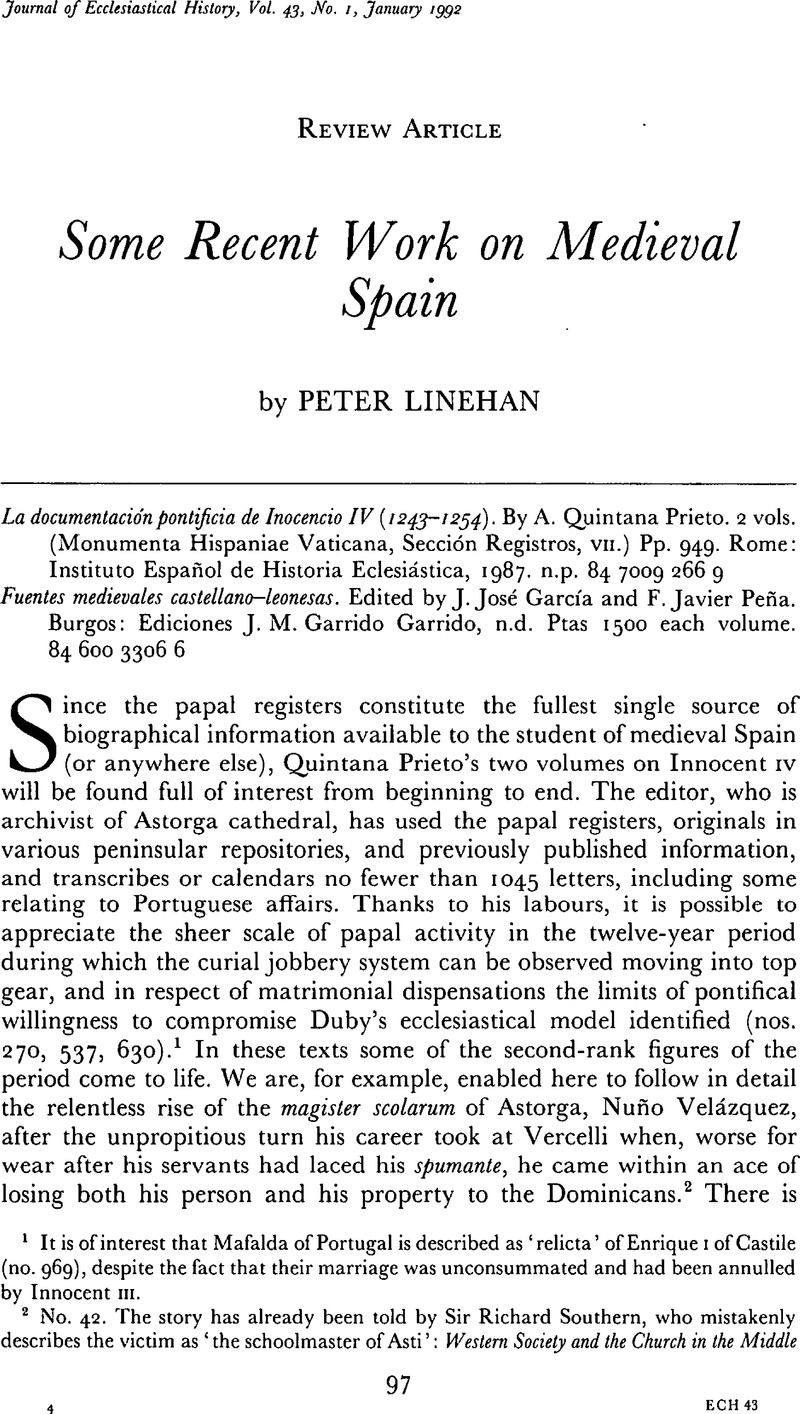Article contents
Some Recent Work on Medieval Spain
Published online by Cambridge University Press: 06 February 2009
Abstract

- Type
- Review Articles
- Information
- Copyright
- Copyright © Cambridge University Press 1992
References
1 It is of interest that Mafalda of Portugal is described as ‘relicta’ of Enrique 1 of Castile (no. 969), despite the fact that their marriage was unconsummated and had been annulled by Innocent III.
2 No. 42. The story has already been told by Richard, Southern, who mistakenly describes the victim as ‘the schoolmaster of Asti’: Western Society and the Church in the Middle Ages, Harmondsworth 1970, 293.Google Scholar The editor further distracts an already sufficiently put upon former member of his own chapter by dividing him into two: Martinus Velasci and Munius Velasci. Cf. Linehan, P., The Spanish Church and the Papacy in the Thirteenth Century, Cambridge 1971, 284–5.Google Scholar
3 E.g. no. 219: ‘presentibus…Domino P. episcopus bosven. (sic); magistro Fernando (recte Bernardo)…; magistro Ricardo, canonico lincolden. (sic); domino Petro Gerietano (rede Gaietano)…’. Cf. no. 1007 where Petrus Gaietanus appears as ‘episcopus toletanus’ (recte tudertinus).
4 Cf. Linehan, EHR xcvi (1981), 903–4, reviewing the volume dedicated to Alexander iv, ed. I. Rodríguez de Lama.
5 For example, a summary check of Reg. Vat. 21 reveals that the letters calendared by Berger as nos. 1664–6, 1783 and 2522 are missing. The thirty-five items printed from the holdings of Archivo Historico Nacional, Madrid, represent less than a third of the number of papal documents of these years preserved in the ‘Sectión del Clero’ alone. Additionally, the signaluras given by the editor are less than reliable: e.g. his no. 37 is not Clero, 3754/13; it is Clero, 1407/9 (= Berger, 444). Cf. Linehan, , ‘Proctors representing Spanish interests at the papal curia, 1216–1303’, Archivum Historiae Pontificiae xvii (1979), 75ff.Google Scholar
6 With Mansilla, D., La documentationpontificia hasta Inocencio III (965–1216), Rome 1955.Google Scholar
7 Ed. A. García y García, 5 vols to date, Salamanca 1981–90. Vols i, ii, and iii are reviewed ante, xxxiv (1983), 620–2; xxxvi (1985), 491–2. The Editors look forward to publishing their reviewer's notice of subsequent volumes of this work.Google Scholar
8 A Hand-book for Travellers in Spain, Centaur Press edn, Arundel 1966, 1262.
9 The objectives of the ‘Proyecto Burriel’, namely the eventual publication of all the materials in the Archivo Capitular de Toledo relating to the years 1086–1495, are explained in Hernández, F. J., Los Cartularios de Toledo. Catálogo documental, Monumenta Ecclesiae Toletanae Historica, I/1, Madrid 1985 (available on request from the publishers, Fundacion Ramón Areces, Paseo de la Castellana 93, 28046 Madrid). Further information is provided in Boletin Burriel, available on subscription from Dr Hernández, Dept of Spanish, Carleton University, Ottawa, Canada KiS 5B6.Google Scholar
10 Colección documental del Archivo de la Catedral de León (775–1230), ed. Sáez, E., S´ez, C., Asencio, C. J. M. Ruiz, Cat´n, C. J. M. Fern´ndez, 5 vols (of 6) to date, León: Centro de Estudios e Investigación ‘San Isidro’ (CSIC–CECEL)/Caja de Ahorros y Monte de Piedad/Archivo Histórico Diocesano, 1987–90; 1677 documents edited so far, down to the year 1187.Google Scholar
11 Documentación de la catedral de Burgos, 804–1183, 1184–1222, ed. J. M. Garrido Garrido (Fuentes, 13, 14). Pp. xxix + 364, xiv + 386; 1254–1293, 1294–1316, ed. F. J. Pereda Llarena (Fuentes, 16, 17). Pp. xxxix + 370, xix + 383.
12 Documentatión del monasterio de San Salvador de Oña, 1032–1284; 1285–1310; 1311–1318: Indices (1032–1318); 1319–1350, ed. I. Oceja Gonzalo (Fuentes, 3–6). Pp. xvii + 381, xv + 384, xiv + 411, xiii + 385.Google Scholar
13 Documentatión del monasterio de Las Huelgas de Burgos 1116–1230; 1231–1262, ed. J. M. Lizoain Garrido (Fuentes, 30, 31). Pp. xlvi + 363, xxix + 371.
14 Documentatión del monasterio de La Trinidad de Burgos (1198–1400), ed. L. Garcia Aragdn (Fuentes, 28). Pp. xxxi + 407.
15 Documentatión del monasterio de San Juan de Burgos (1091–1400), ed. F. J. Pena Perez (Fuentes, 1). Pp. lxi + 336.
16 As, for example, in the interrogation of witnesses in 1323–4 regarding the rights of the monastery of Oña in the church of Santa Olalla de Liencres, which occupies ninetyfour pages of Oceja Gonzalo's work (no. 601), and in that of Peña Peréz the 1356 rental of San Juan (no. 150).
- 1
- Cited by




